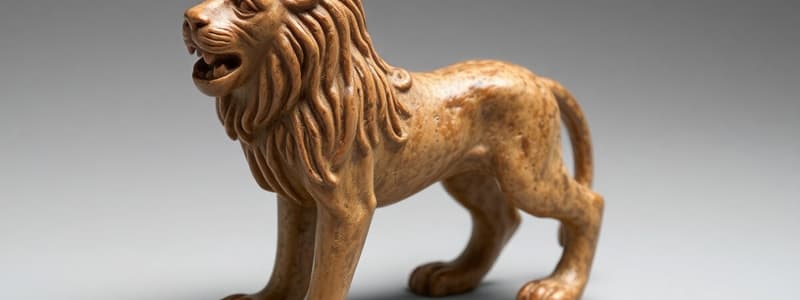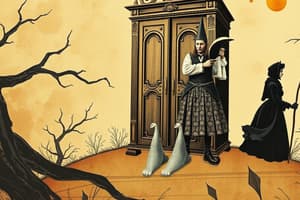Podcast
Questions and Answers
What does the wear on the Lion Man statue suggest about its use?
What does the wear on the Lion Man statue suggest about its use?
- It was primarily used as a tool for hunting smaller animals.
- It was used to grind pigments for cave paintings.
- It was a decorative item displayed in a prominent location.
- It was passed around and rubbed as part of a narrative or ritual. (correct)
What material was used to create the Lion Man statue?
What material was used to create the Lion Man statue?
- Reindeer Antler
- Arctic Fox Bone
- Mammoth Tusk (correct)
- Limestone
Why might the creation of the Lion Man have strengthened common bonds within the Ice Age community?
Why might the creation of the Lion Man have strengthened common bonds within the Ice Age community?
- It provided a practical tool for hunting and gathering.
- The time investment suggests the image's purpose was about strengthening common bonds and group awareness. (correct)
- It was used as currency to trade with neighboring tribes.
- It demonstrated advanced artistic skills that attracted new members to the community.
How does Stadel Cave, where the Lion Man was discovered, differ from other caves in the region with archaeological discoveries?
How does Stadel Cave, where the Lion Man was discovered, differ from other caves in the region with archaeological discoveries?
What does the presence of the Lion Man, arctic fox teeth, and reindeer antlers in a dark inner chamber of Stadel Cave suggest?
What does the presence of the Lion Man, arctic fox teeth, and reindeer antlers in a dark inner chamber of Stadel Cave suggest?
Besides the use of tools and fire, what distinguished humans from animals during the time the Lion Man was created?
Besides the use of tools and fire, what distinguished humans from animals during the time the Lion Man was created?
What might the hybrid nature of the Lion Man (part human, part animal) symbolize for Ice Age people?
What might the hybrid nature of the Lion Man (part human, part animal) symbolize for Ice Age people?
What was a unique physical characteristic of the lions of that time, compared to modern African lions?
What was a unique physical characteristic of the lions of that time, compared to modern African lions?
Flashcards
The Lion Man
The Lion Man
The Lion Man is a prehistoric sculpture found in Germany, carved from a mammoth tusk and depicting a lion, a creature extinct at the time. It is considered a significant artifact for understanding Ice Age art and human beliefs.
Wear on the Lion Man
Wear on the Lion Man
The wear and tear on the Lion Man suggests that it was frequently handled, indicating its use in narratives, rituals, or ceremonies.
The Lion Man's Significance
The Lion Man's Significance
The Lion Man's existence as a significant artifact suggests that Ice Age societies had complex beliefs and practices, possibly including stories, rituals, and an understanding of spirituality.
The Lion Man's Hybrid Nature
The Lion Man's Hybrid Nature
Signup and view all the flashcards
Time Invested in the Lion Man
Time Invested in the Lion Man
Signup and view all the flashcards
Stadel Cave
Stadel Cave
Signup and view all the flashcards
The Lion Man's Placement
The Lion Man's Placement
Signup and view all the flashcards
Lion Man and Religious Beliefs
Lion Man and Religious Beliefs
Signup and view all the flashcards
Study Notes
Lion Man Figurine
- Discovered in Stadel Cave, southern Germany in 1939, carved from mammoth tusk.
- Shows a lion, extinct species; 30cm taller than modern African lions, no mane.
- Displays significant wear, suggesting repeated handling, likely part of a ritual or narrative.
- Unknown purpose, potential roles: deity, spirit intermediary, creation story figure, human transformed by a cosmic journey
- Highlighted the interplay between humans and animals, perhaps addressing humanity's place in nature.
- Estimated creation time: over 400 hours using Ice Age stone tools (Wulf Hein's experiment).
- Indicates the community prioritized the sculpture, suggesting function beyond immediate survival or strengthening communal bonds, beliefs, and rituals.
- Found in a dark inner chamber in Stadel Cave.
- Cave's characteristics: north-facing, less sun, less habitation debris. Sparse evidence suggests occasional use for gatherings, beliefs, and shared understanding.
- Suggests a connection between beliefs and social cohesion long before writing.
- Supported by similar small carved figures found in caves of the region and dated to the Ice Age (Ice Age Art: arrival of the modern mind, British Museum exhibition).
- Other caves contain evidence of prolonged human habitation in lighted areas (stone tools, animal bone remains).
Studying That Suits You
Use AI to generate personalized quizzes and flashcards to suit your learning preferences.




